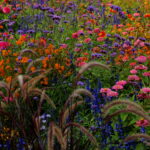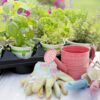Can a garden thrive all year round, even with the seasons changing? For garden lovers in cities like Toronto, Ottawa, and Montreal, this dream is real. They use a perennials and annuals mix to make their gardens vibrant and lively. This mix combines the lasting beauty of perennials with the fresh colors of annuals. Together, they create a dynamic garden design that always surprises and delights.
Perennials are the foundation of the garden, coming back every year to add depth and beauty. Annual flowers add new colors and ensure the garden is always in bloom. By using both, gardeners get a garden that looks great from spring to fall. This approach makes a colorful garden design that changes with the seasons but stays beautiful.
Gardeners can arrange perennials and annuals thoughtfully to make their garden look new every year. Experts like those at Dennis’ 7 Dees Garden Centers offer tips on how to do this. By choosing the right plants, gardeners can create beautiful scenes that last longer and look better. This approach not only makes the garden look great but also helps the environment and attracts pollinators.
The key to a thriving garden is knowing how plants grow and change with the seasons. By understanding this, gardeners can make their gardens truly come alive. It’s all about finding the right balance of growth and color to create a space that’s full of life.
The Art and Science of Combining Perennials and Annuals
Masterfully planting perennials and annuals together isn’t just about filling spaces. It’s about creating a beautiful mix of colors, textures, and seasonal changes. With the wide variety of plants available, you can make your garden reflect your style and care for the environment. By pairing perennials with annuals, you get a garden that’s lively all year round.
For example, cool-season annuals like pansies and snapdragons start the year off with color in the fall. When they fade, warm-season annuals like petunias and zinnias bloom in late spring. This way, your garden always looks great.
Adding big perennials or small trees to your garden gives smaller plants a strong base. It also brings different textures and heights to your garden. Containers are great for these mixes, with big ones holding shrubs and perennials for structure. Small containers can change with the seasons, using annuals to match your garden’s colors.
Experts like Mike Ruggiero from New York Botanical Garden teach the art and science of planting perennials and annuals. He shows how important it is to use bold strategies with annuals to make the most of their growth and colors.
The key to mixing these plants is knowing how they grow, look, and live. This knowledge makes your garden more beautiful and sustainable. It ensures plants fit the local climate and soil, creating a healthy, thriving garden.
Mixed Garden Ideas: Building a Vibrant Palette
Creating a colorful garden design is more than picking plants. It’s about seeing your garden all year round. You need to choose plants that look good together and grow well. It’s important to know how perennials and annuals work together in your garden.
Studies show 25% of garden plans use easy-care perennials for beginners. These plans often include plants that are tough and colorful from spring to fall. For example, a garden with pink, purple, yellow, and white flowers can stay colorful all season.
Adding annuals to your garden makes the colors change with the seasons. Annuals bring bright colors in midsummer when perennials may fade. Tall annuals can also add height and shape to your garden. Consider the ‘New Zealand Purple’ castor bean for a bold look.
Where you put plants is also key. Grouping them by color and size helps each plant get enough light and be seen. This makes your garden look better and is easier to take care of.
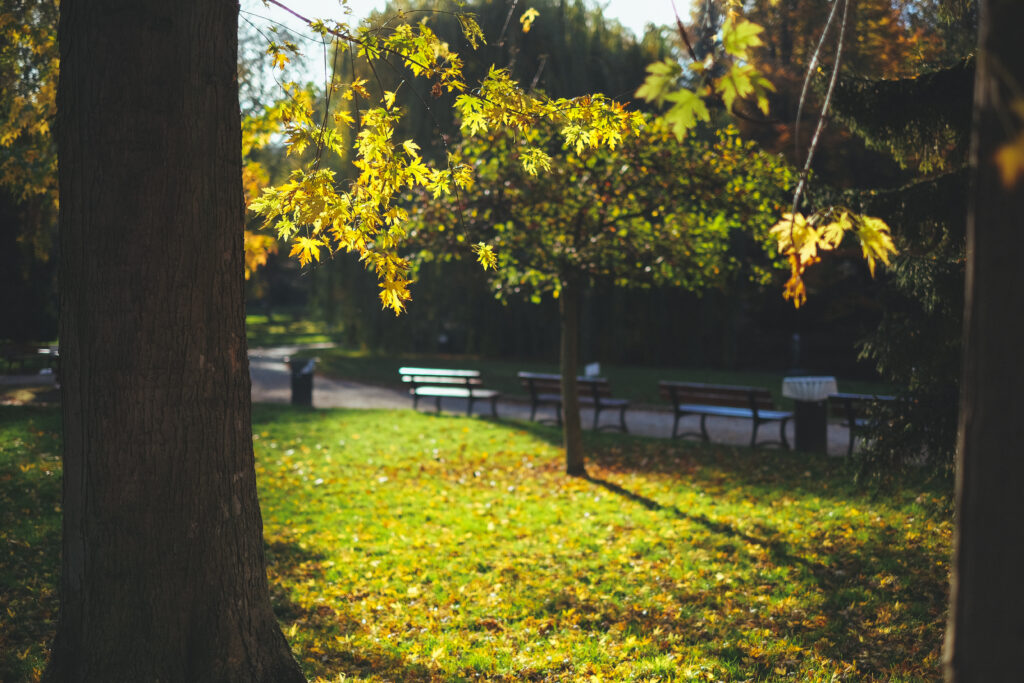
Mixing perennials and annuals means your garden can change and grow with the seasons. Plants like poppies can fill in and add color while other plants grow. This way, your garden stays lively and changes with the weather and climate.
Planning is crucial for a successful mixed garden. Visit sites with good gardening advice all year, like this helpful resource. These guides can help you pick the right plants for your garden.
Creating a colorful garden is like making art that you can touch and see. With careful planning and the right mix of plants, even beginners can make a garden that brings happiness and peace.
Planting Perennials and Annuals: A Seasonal Approach
Learning about planting perennials and annuals is crucial for a dynamic garden design. Perennials last for years and save money on replanting. They become the main part of your garden, blooming every year. Annuals, on the other hand, brighten up with their colors and textures, changing every year.
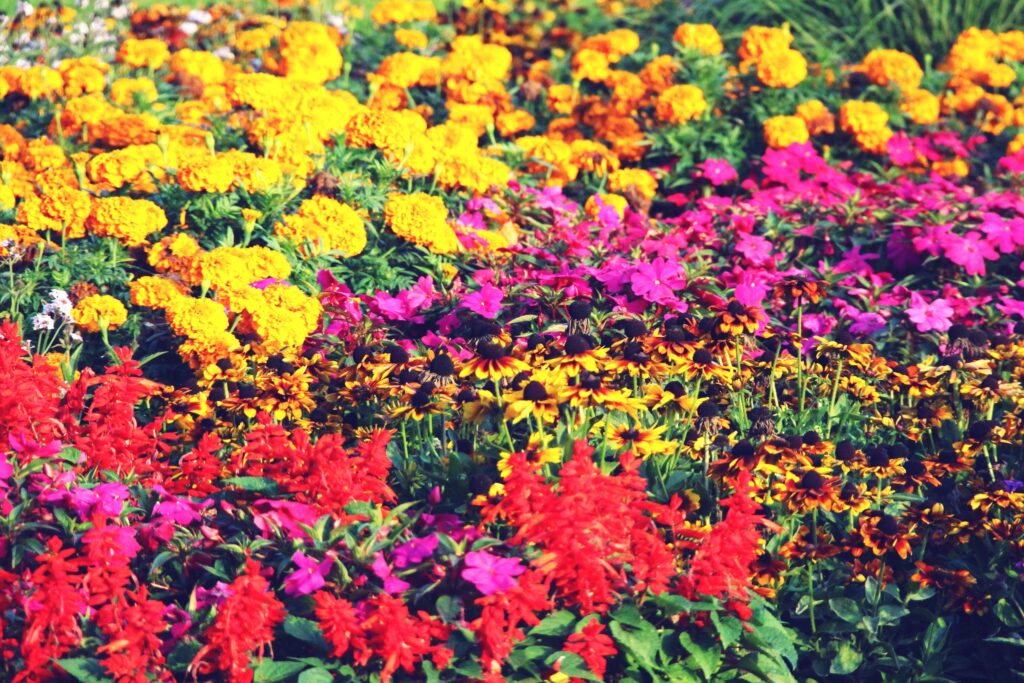
Spring is the best time to start gardening. It’s perfect for planting strong, early perennials and cold-hardy annuals. This mix starts the garden’s colorful display, helps pollinators, and sets the garden’s look.
Summer brings heat-loving perennials and annuals that do well in the warmth. These plants show off bright colors and create a lively garden. They make the garden look great as they grow.
In fall, we focus on annuals that like cooler weather. These plants keep the garden colorful and match the colors of fading summer perennials. This shows the careful planning in planting perennials and annuals.
This way of planting makes the garden look better and helps nature. It uses dynamic garden design ideas that match nature’s cycles. By picking plants that grow well at different times, gardeners create a garden that’s beautiful all year. It stays colorful and supports many kinds of life.
Cultivating a Colorful Garden Design through Creative Combinations
Creating a colorful garden design is more than just picking different flowers. It’s about choosing wisely to blend perennials and annuals. This mix makes a garden look great all year and helps it grow well season by season.
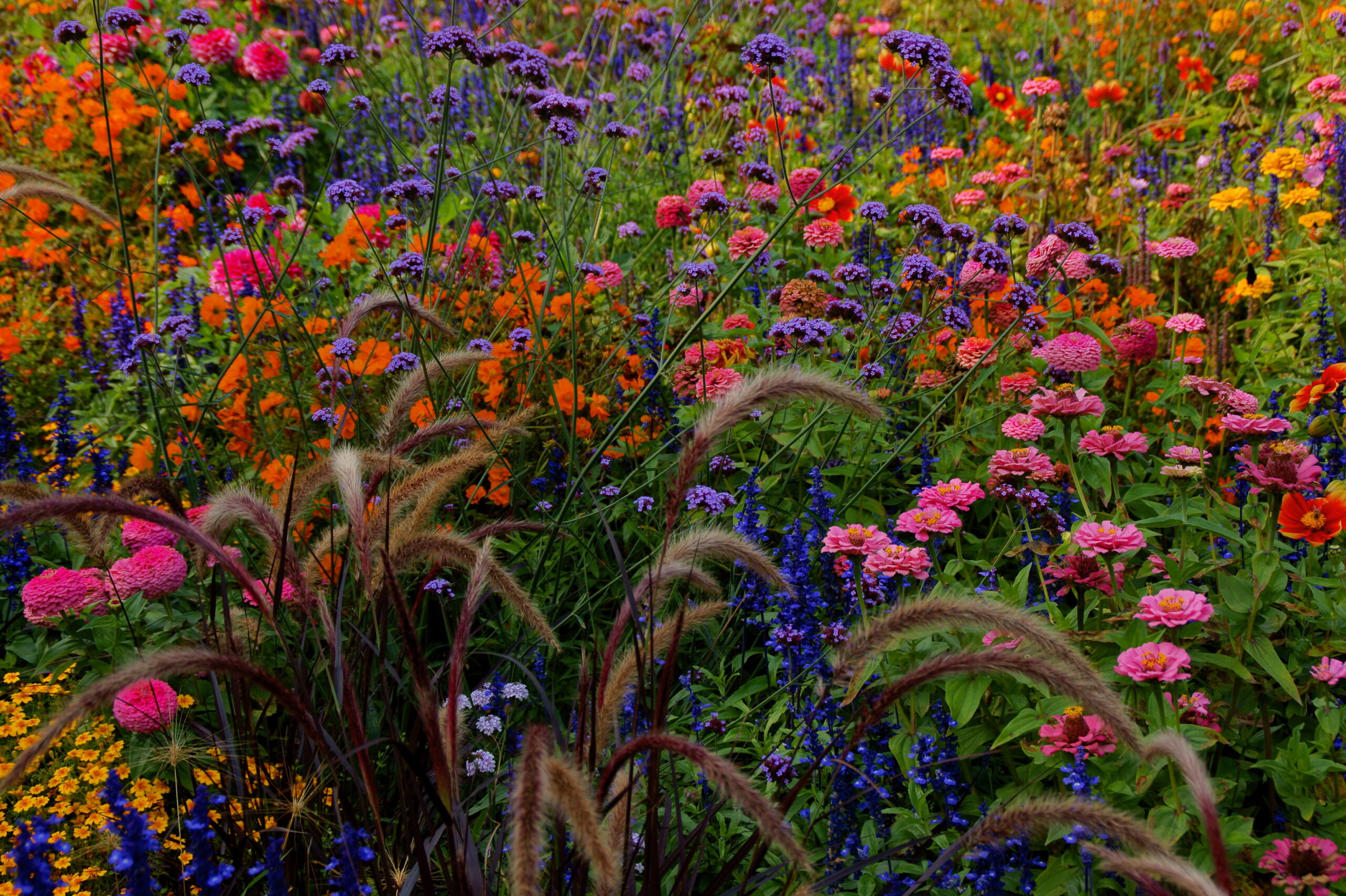
In cities like Toronto, Ottawa, and Montreal, gardeners use early-blooming perennials and vibrant annuals. They mix peonies with pansies and snapdragons. This way, as perennies fade, annuals take over, keeping the garden colorful.
Summer brings its own mix. Perennials like coneflowers and daylilies are paired with annuals like petunias and marigolds. These plants keep the garden colorful all summer.
By autumn, adding chrysanthemums and ornamental kale gets the garden ready for winter. These plants can survive the cold, keeping the garden looking good.
Good garden planning is about more than colors. It’s also about height and texture. Taller perennials and lower-growing annuals create a layered garden. This makes the garden look rich and full, with perennials and annuals working together year after year.
For small gardens or city spaces, using containers is a great idea. It lets you mix perennials and annuals easily. This makes your garden flexible and easier to take care of.
As the seasons change, keeping your garden colorful is fun. Mixing perennials with annuals helps them grow better together. This makes colorful garden design a living, changing work of art.
Diverse Plantings for a Garden Full of Life
Creating a dynamic garden design means mixing annuals and perennials. This mix ensures your garden looks great all year. Pioneers like William Robinson and Gertrude Jekyll showed us how to use annuals with perennials for a balanced look.
In places like the Chicago suburbs, gardeners deal with changing weather and pests. Annuals like wavy petunias and sunflowers fill gaps in perennial borders. Plants with soft colors, like Chinese forget-me-nots, add a special touch to the garden.
Planning is key when planting. You need to replace soil, use mulch, and protect against deer. Places like Countryside Nursery and Hawthorne Gardens are great for finding plants like hydrangeas and rose bushes.
To blend annuals with perennials well, place them thoughtfully. For example, put impatiens in the shade and dahlias in full sun. This way, each plant grows well and adds to your garden’s look and health.
A dynamic garden design changes with the seasons, thanks to perennials and annuals. Each type adds its own beauty, making your garden a welcoming place all year. By using these tips, you can make your garden a vibrant part of nature.
Combining Perennials and Annuals for Year-Round Interest
Creating a garden that looks great all year takes careful planning. Mixing perennials and annuals together gives us colors and textures that keep our gardens interesting. Perennials come back every year and bloom at different times. They are more expensive and need more work, like dividing the roots and removing dead flowers.
Annuals, on the other hand, bloom for one season but fill in gaps between perennial blooms. They add vibrant colors to the garden. By combining them, we get a garden that looks good all year. We can use plants like geraniums, marigolds, salvias, cosmos, and petunias for this mix.
Annuals like snapdragons and marigolds bloom more and stay healthy if we remove dead flowers. Some annuals, like vincas and certain geraniums, clean themselves. Feeding them with special fertilizers makes them bloom even more. Zinnias and celosia add life to the garden with their many colors and textures.
Even when we face challenges, like working from home during COVID-19, gardening keeps us going. The El Paso County Extension shows us how to make our gardens bright and full of life.
Using perennials and annuals together makes our gardens lively all year. We can choose plants like coleus and fountain grass to make our gardens interesting. With guides like ‘The 25 Best White Flowers for Your Garden’ or ’23 Gorgeous Tropical Landscape Plants’, we can make gardens that are beautiful and sustainable.
By mixing perennials and annuals, our gardens become more than just pretty places. They show the lasting beauty of nature.


